Held within are details of the creatures and plants that make Falyndar the deadly, dangerous, and breath taking environment it is. Contributions can be made through the Amidst the Canopy Forum and through the WD, thank you to all contributors. |
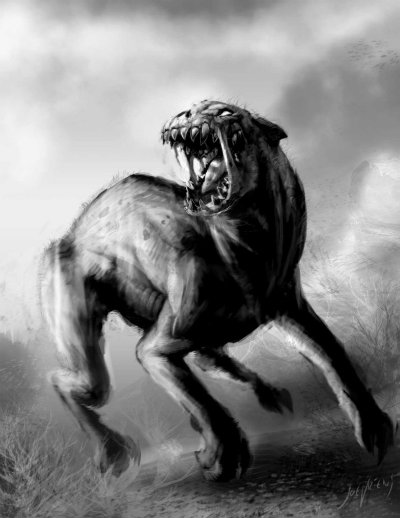 Akila HoundsCharacteristics: Akila HoundsCharacteristics: Standing at around 20-30 inches from ground to shoulder in height, the Akila Hound is a muscular predator to be avoided in the jungle. Its fur is short and colored a grayish black. Three sharp claws protrude from its paws and its monstrous jaw is large with the strength to crush bones. Its eyes are a milky, reflective hue that aid its vision in the night. The Akila Hound is strictly carnivorous. The creature is a fine specimen of stamina, agility, power, and speed while on the hunt. They are aggressive and territorial by nature. Common Locations and Frequency: This stocky hunter is relatively uncommon, especially near more developed areas of civilization. In the depths of the jungle, however, it isn't a surprise to see traces of their activity. The Akila Hound is primarily a ground dwelling animal. It may race along lower trees or muscle its way up toward prey hiding within lower branches of the emergent layer of the forest, but never will you find one even close to the canopy. This canine is nocturnal and thus it will almost never be encountered during the daylight. Social Structure and Pursuit: Caiyha's Reckoning (a nickname of the infamous canine) is a very social animal. They travel in packs and it is a rare sight to see one completely alone. There are no true ranks of the group, per say, but there is organization. Within their packs of 5-10, hounds may fight for dominance. Once a victor emerges the rest will fall into their rightful places. Oddly enough there is an unspoken understanding among them as a whole. Each understand individual strengths and weaknesses and divide themselves in their roles accordingly. What makes them truly dangerous is their utilization of both the powerful individual in combination with the attributes of the pack as one. As pack animals the Akila Hounds will track and hunt down prey collectively. As soon as a potential victim has been spotted, a pack member may release a bloodcurdling howl to alert the rest of its group. If the prey is close and appears to be making no attempt at escape, the Akila Hounds may instead opt for stealth. Sneaking up in the darkness until the pack has surrounded the victim. Perhaps even out a heckling growl or two. Each member has its own job in the chase. Some may flank the quarry to encourage it in one direction (or to deter it from changing its course) while the others have a go from behind. Claws may be utilized in attacks but their ultimate goal is to sink their teeth into flesh. With the vice-like grip of their jaws, it's very unlikely whatever they were hunting will escape once captured. Not alive at least. Diet and Tendencies: These predators will risk challenging just about anything edible. Larger prey such as the Tskanna will be deemed too troublesome to pursue unless weak or juvenile. Leopards, tigers, panthers, and etc. are less likely to be directly threatened by the Akila Hounds. However the pack will not overlook contending another predator's kill to take as their own. They will scavenge just as readily as they will hunt. Miscellaneous: Due to their reputation, not many fur traders dare pester the Akila Hound packs. With their impressive physique and known reputation as outright vicious monsters, they do make great decorations around a place of abode. Any who encountered one of the beasts and lived to tell the tale is considered lucky. Few storytellers forget to leave out descriptions of their haunting, malevolent howls and throaty growls. If one is slain, the thick, strong bones may fetch a good price. Few who've gotten their hands on the remains of an Akila Hound may find they make excellent weapons and weapon accessories (i.e. Clubs, spearheads, arrowheads, daggers, handles). Credit to Kaie |
 Ethereal Jaguar Common Locations: Ethereal Jaguar Common Locations: While by nature they roam, the Ethereal Jaguar favors Cloud Forests. Although, they will venture down into lower jungles during Monsoon seasons to find cover. Frequency: Rare due to the low birthing rate among females. Characteristics: Ethereal Jaguars on average are 3 feet tall at the shoulder, and 10-12 feet long depending on tail size. Their ears end in wispy points; they have long sharp claws, and wicked fangs. From afar it looks as though the Jaguar is in constant motion, or that a breeze is constantly blowing across its fur. This is due to the pattern of its fur, and features, which flourish at the ends and give it a sense of motion at almost all times. The Jaguar has light grey fur, with darker spots along its body, and its irises are white as well (however it is not blind). The Jaguar instead is much lither than its tiger counsins, with lean dexterous muscles, which make it a lightning fast ambush predator. Social Structure: Ethereal Jaguars are solo predators. The males have no fixed home, and will roam across vast expanses in pursuit of mates and prey. The females will roam for a time, but upon mating will settle down in a region in order to raise its young. The period of rearing doesn’t last long, however, consisting of just enough time to birth the young and then teach them the basics of the hunt. After this year long period the mother will leave her young, and continue to live a solitary life. In a single female’s life, she will only have two litters, consisting of no more than two offspring. The young reach maturity two years after birth and full stature after four years. Ethereal Jaguars are known to live 15 - 20 years at most. Miscellaneous: When hunting the Ethereal Jaguar keeps low to the ground, and tries to remain in constant motion, which in unison with its features and fur pattern, make it seem like a blurred illusion. All of this coupled with the Jaguar’s natural capabilities of stealth, and preferred terrain of hunting, make it a deadly predatory. Also the Ethereal Jaguar is not above simply wounding its prey and stalking it, this allows it to occasionally hunt larger prey or prey in groups. The rarity and beauty of these jungle cats causes them to not be often hunted, and it is whispered in tales of how Akajia herself told Caiyha a story that inspired these stealthy nocturnal predators. However, if one is killed as a result of a self-defense situation, then the pelt can fetch a high price in both Zinrah and Taloba. Alternatively the pelt can be fashioned into a very unique piece of attire, that mimics the natural illusory pattern of the Ethereal Jaguar. The silvery pelts are treasured by Dhani both for camouflaging and simply the prestige that comes with having such a rare coat. Myrians see the Ethereal Jaguar as just that, a guardian of the mists and the more dangerous places of the wilds, it is a creature revered and respected and a gift to gaze upon once in a lifetime if you are lucky, so killing one is usually seen in a negative light. Credit to Dragul |
Rhilgor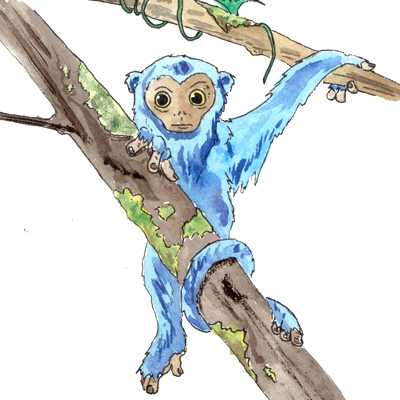 Pelts can fetch a pretty bone in the markets, but good petching luck catching one of 'em. Pelts can fetch a pretty bone in the markets, but good petching luck catching one of 'em. - A Myrian Trader on Rhilgor Frequency/ Location: It is rare to find a wild Rhilgor anywhere but leagues away from Taloba or any larger outlying clan, as well as the barricade around Zinrah. Rhilgor have been captured and bred to be sold in the trading square of Taloba, and this is the most common place to see one. Generally troops of these primates occupy high density Cloud Forests at high elevations, one of the few places in Falyndar that can get to chilly temperatures. Their thick and water resistant fur serves the Rhilgor well in these higher altitudes, and even their bright coloring is not a hindrance in the thick fog banks that often form at such heights. OverviewThe Rhilgor is an aboreal primate native to the Jungle Wilds of Falyndar. Quick, agile, and intelligent they move in troops ranging from 10 -20 of the monkeys, foraging and frolicking in the canopies of the jungle. Their name is slang for 'Blue Lion' in Myrian, a title earned because of the stand out ruff the males of the species gain during maturity. Quieter than howler monkeys and smarter than capuchins, the Rhilgor stay far away from populated areas, and favor the upper cloud forest, and are a fascinating find, as well as a well sought after treasure because of their uniquely colored pelts. Characteristics: Rhilgor are small monkeys roughly 2 feet in length (3.5 including the tail) and usually weigh less than twenty pounds, males just broaching this mark. Their fur ranges from a nearly white sky blue color to a deep cobalt in color, but these are outliers for the general hue lies in the range of azure. No one to date has been able to identify what precisely determines coat color, though migratory patterns indicate that the creatures follow certain flowering plants and fruit bearing trees, this seems to differ from troop to troop. Rhilgor possess thick coats and water resistant fur as well as prehensile tails 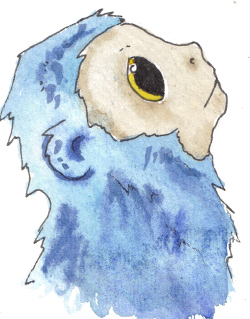 and opposable thumbs, though only four fingers. This allows them finer manipulation of opening fruits and nuts as well as weaving intricate bedding int he trees out of large leaves. These structures are sometimes used for weeks at a time, and have been found left at sites in which a Rhilgor troop had previously foraged. Teeth arranged much like a humans allow for the processing of both plants and meats, and their omnivorous nature is one of the facts that contributes to the Rhilgor's superior intelligence in reference to several of its primate cousins. Wide yellow eyes allow the Rhilgor to have vision in dim lighting conditions, aiding them int he foggy conditions of the cloud forests they call home, but the Rhilgor are primarily diurnal in nature. BehaviorRhilgor are an intelligent breed of primates that has taken their survival in stride. Occupying areas as far from their main predators (Dhani and Myrians) Rhilgor enjoy lives of solitude and peace, with little threat to their safety that cannot be avoided by staying high in the trees. They have very complex mannerisms when it comes to troop dynamics, much like other primates, a constant social struggle occurring between Rhilgor for standing and hierarchy. While in most primate troops a large male acts as the head of the collection, it seems that leadership is interchangeable between male and females among the Rhilgor, a particularly resourceful female that brings more food goods or proves to be a superior weaver can be displaced over a particularly aggressive or powerful male, making for a more complex system of determination within a Rhilgor troop. Social Structure: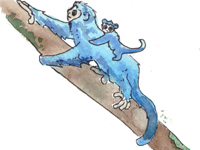 Breeding rights among Rhilgor consist of the oldest or most respected females choosing the males. This takes place in a courting ritual consisting of much grooming of fur, and socializing in a very tight knit way over the course of several weeks, where in pairs of Rhilgor will retire to woven nests. This period happens in the early winter. Pregnancy generally lasts 6 months, with one infant being born, very rarely twins, to a single Rhilgor. During the birthing period the troop will make a more permanent settlement in the canopy for several months. Infants are raised communally, and will often suckle off of females not their own mother. Baby Rhilgor will often swap mother's and families frequently, but always return to their biological parent when the troop makes to leave at the end of Spring in the next phase of migration, clinging to their mother's back. The lifespan of a Rhilgor in captivity is generally 15 years, and in the wild has yet to be measured. Miscellaneous: Rhilgor were discovered shortly after the founding of Taloba. It is said the primates were blessed by Makutsi, which explains their blue coats, though many call this folly. Regardless of what events led to their creation, the hunting of Rhilgor is something taken very seriously. While the rarity of the primate has led to hunts in the creatures honor, Myrians and Dhani alike are very wary of killing too many of the Blue Lion lest they incur Caiyha's wrath. That being said, it is not unheard of for a Myrian to have obtained a Rhilgor as a pet, and they are bought and sold. They are seen with respect due to their intelligence and intense survival capabilities. |
Wanolo Baboon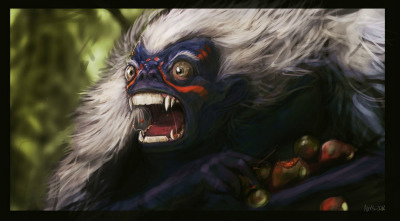 Common Locations: Common Locations: Throughout the rain forest regions of Falyndar. Frequency: Common Characteristics: Covering the backs of these vibrant blue primates is a thick layer of long, white fur. Their faces are relatively small with significantly large mouths and eyes, which appear almost bugged when agitated. A long line of red runs from their cheek bones, over the bridge of their nose, and down from the area just above their temples. On average they weight about 30 kg and stand as high as 55 cm. These monkeys have no tails. Their diets include mostly fruits and nuts that grow high in the trees out of reach of potential predators. These monkeys almost never leave the safety of the canopy, and very rarely would dare climb as low as the understory. The Wanolo Baboon is extremely reclusive and wary of anything outside its own species. They're fairly easy to startle, and even the slightest disturbance can send an entire troop into a panic. Threats are treated with great hostility, which are often met with screeching, bugged eyes, and incisors exposed. They will avoid direct face to face conflict at all costs and remain distant. Any who are foolish enough to catch their attention, however, will receive a monsoon of fruit hurled down upon them. Social Structure: The Wanolo Baboons live and travel in troops ranging between fifteen and twenty baboons. They are usually led by two or three dominant primates, male or female, who constantly battle for supremacy. Their families are close knit and young are protected by the entire troop. These monkeys do not mate for life. Credit to Empyrean |
The Comet Blood MothOverview: 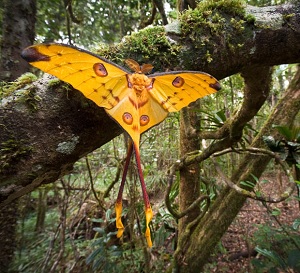 The Comet Blood Moth is a moth native to the tropical forest of Falyndar. The male is about the size of a small bird with bright shade of yellow with four brown fake eyespots, two on each wing. Its wingspan is anywhere between 12-15 inches while its tailspan is 10 inches. The female is half the size of the male with light brown and dark brown coloring to blend in with foliage. Unlike the male it has no tail. Both are hematophagous (creatures that feed on blood) that have adapted after the Valterrian to feed mainly on the Tskanna. Nocturnal by nature has earned it the nickname of Lunar Moth or Were-moth. Social Structure/ Breeding: The Comet Blood Moth mates in late winter so by the time the eggs hatch 40 days later its still hot and before the floods come. The courtship between a male and female is simple. The female when its ready to mate gives off a strong pheromone resembling the smell of decaying flesh. Once a male finds a willing partner he will begin a show of flapping his wings and flittering before her. If she accepts his dance she will mimics his moves and they will begin to copulate. Once done, the female usually kills and drinks the blood of her partner for a quick metabolism boost to lay her eggs. The female can lay anywhere between 120-170 eggs in one mating season then leaves. The eggs are a favorite of birds so their survival rate is only about 40 of the eggs actually hatching. 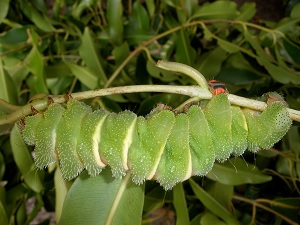 The caterpillar is still vulnerable until it pupates. However it does have a slight edge of protection by fuzzy barbs all over its body that irritates predators esophagus if swallowed. Since its main food source is out of its reach until it can fly it relies on slow moving bugs and feeds on its nutrients instead. It will continue to feed until right before summer and pupates, reaching almost a foot in length. The caterpillar finds a branch high in the canopy and begins with a layer of waterproof silk that protects it from the rains and monsoon like conditions. Then it begins to harden into a chrysalis which has several holes in it to keep the pupa from drowning. It remains as such until Autumn where it emerges in the light of full moon. An adult Comet can live up to five years. 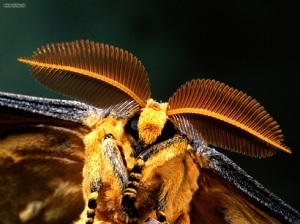 Feeding Habits: Feeding Habits: The Lunar Moths sleep during daylight bells and rise from its slumber at dusk. The Moth instantly seeks out the Tskannas. It uses its barbed like tongue to pierce the skin and drink. Its saliva has anticoagulant properties which keeps the wound open and the blood flowing. It can drink up to a pint of blood in one feeding session. The wound doesn't harm the Tskanna and will eventually close up in a few bells. After a successful feeding session the moth doesn't need to seek out a donor for a few days. Miscellaneous: Myrians like to tell children that If they stay out in the jungle late at night on a full moon a Comet Blood Moth will come and bite them. A few days after the bite and cold sweats the children will become Lunar moths themselves. Credit to Soliloquy |
Winged LeechCommon Locations: Kandukta Basin  Frequency: Frequency: Uncommon, Common during monsoon seasons. Overview: Just as its name implies, the Winged Leech is a bloodthirsty insect by nature. It surfaced just after the end of the Djed Storm, and is believed to be the consequence of Djed exposure to the leech population. They are almost found exclusively in Falyndar for its favoritism of humid climates. Characteristics: Overall the insects are no larger than the pad of one's thumb. They can easily be distinguished from other bugs by their squishy pink or purple bodies, green plating down the spine, and long tongue. Other notable features are its four wings and stringer. In addition to its odd, three digit extremities, the Winged Leech also has a pair of green exoskeleton legs. This creature has no eyes. To make up for this its tongue has a unique ability to actually taste potential prey in the area, which is why its tongue is almost always visible. These insects are not particularly bothersome most of the time. They may hover about curiously before latching on, and don't seem too bothered when swatted at. On the contrary, during monsoon season they become agitated easily and far more insatiable. Social Structure: Winged Leeches tend to be gregarious. Although none fear to venture alone, it's extremely rare to see less than three, but no more than fifteen, at a time during most seasons. In monsoon season it's guaranteed to find swarm numbers expand up to sixty. Instead of battling for rights to a victim, they instead recognize the efficiency of attacking in numbers. Miscellaneous: In most cases the Winged Leech behaves like a parasite when not swarming. After tasting prey with its tongue it will descent down and attach itself to the surface. Being relatively tiny, the insect doesn't take too much blood at once. Instead when its full it may remain attached to its food source until hungry again. However if its host is less than accommodating, it will use its stinger to inject anesthetic toxins to the bloodstream. This is not usually a fatal poison since but it can be in a swarm scenario. Massive clouds of hungry Winged Leeches will prove highly dangerous. Together they will draw out excessive amounts of blood and its natural drug may cause an overdose. Credit to Empyrean |
| Specimen | Name | Nicknames | Characteristics | Other | 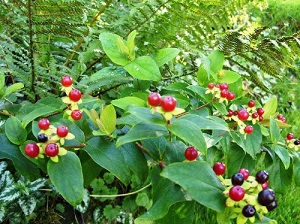 | Maia Berry | Jungle Rot, Jungle death | A large shrug that grows roughly 3-4 ft in height. The leaves are round teardrop shapes in bunches of four. Each one is an inch to inch and a half in a width. The underside is usually fuzzy to the touch and is a irritate if comes in contact with eyes, nose or mouth. Berries can be found on it year round but don't become ripe until early summer, of which it goes from a deep purple color to a bright red. | The Maia Berry is an annual but is usually avoided due to its poisonous nature. Nicknamed Jungle Rot or Jungle Death because if one is to consume the berries the experience horrible stomach cramps, internal bleeding and severe diarrhea. The berry produces a hemotoxin that breaks down tissue and after a slow and extremely pain, death usually follows unless an antidote is used. | 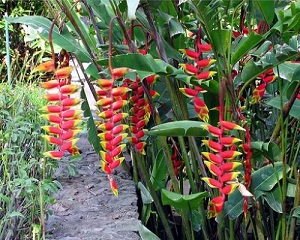 | Firecracker Flowers | Poppers, Parrot beaks | A medium sized flowering plant that grows anywhere to 3-6 feet in height. The leaves are large evergreens that are 7-22 inches long and 3-10 inches across. The plant is very sensitive to cold and will go into shock and eventually die if temperatures reach anything below 60-70 degrees Fahrenheit. The flowers start off growing upright and as they are about to bloom (late winter/early spring) they flop over. They release a sweet smell resembling something of honey. | Firecracker Flowers are harmless and have no real purpose other than decoration and slight mischief. If one were to pluck one of the flower buds and throw it upon the ground, a quick pop will be produced. Popular amongst the youth of Falyndar for pranks a plenty and a quick scare. Pranks aside makes an excellent deodorant as well. Besides the popping noise it also releases a honey scent burst into the air. | 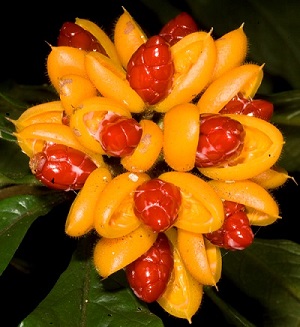 | Scaly Pinecone | Beetle fruit | A parasitic vine that grows up the sides of huge trees in the forest. The leaves are fairly small and oval shaped only coming in at half an inch at the widest point. Mid-spring it produces a bright yellow bunch that looks similar to a giant pinecone. In the summer each little pocket opens up revealing a red fruit inside. At this point it is ripe and the whole thing can be eaten, just a matter of scaling the tree to get to them. | Scaly Pinecone's seeds are distributed by birds and monkeys who feed on the fruit and seeds are dropped by means of their waste. It doesn't take the seeds long to germinate and quickly start growing. Due to its small leaves it cant get adequate sunlight to support itself so it grows up a side of a tree and leeches its nutrients. Often times completely taking over a tree and killing it in the process. The fruit itself tends to between a sour and a sweet flavor resembling the flavor of oranges. | 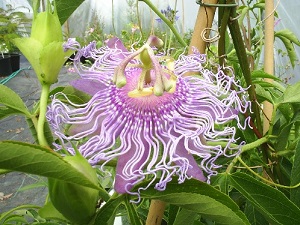 | Xelma flower | Passiflora | A flowering shrub that grows 8 ft in height under the right conditions. The leaves are a pale green with darker undertones underneath. Each leaf is shaped like that of a bird's foot and 3 inches in length. The Xelma flowers all summer long and is particularly fragrant at night, filling the air with a sweet pea smell. The shrub also produces purple round fruit in the winter time. The flesh will turn yellow when ripe and has a soft to firm, juicy interior filled with numerous seeds. | Due to its shape of the flower only a large bee, butterfly, hummingbird, and/or bat can truly pollinate it properly. The leaves and roots can be harvested and used dried or fresh to make teas. The tea can help with treat insomnia, hysteria, and epilepsy, and is also valued for its painkiller properties. Dried leaves can be smoked but are a very potent hallucinogen but some have claimed to be an antidepressant as well. The fruit can be eaten once peeled or can be mashed up and drank. |
|
![]() by Traverse on November 18th, 2013, 3:17 am
by Traverse on November 18th, 2013, 3:17 am ![]() by Traverse on May 25th, 2014, 3:24 pm
by Traverse on May 25th, 2014, 3:24 pm 





